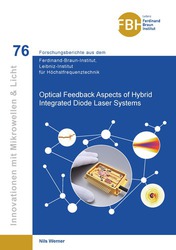| Areas | |
|---|---|
| Serie de libros (96) |
1377
|
| Nachhaltigkeit |
3
|
| Gesundheitswesen |
1
|
| Letra |
2361
|
| Ciencias Naturales |
5403
|
| Matemática | 229 |
| Informática | 318 |
| Física | 979 |
| Química | 1362 |
| Geociencias | 131 |
| Medicina humana | 243 |
| Estomatología | 10 |
| Veterinaria | 108 |
| Farmacia | 147 |
| Biología | 835 |
| Bioquímica, biología molecular, tecnología genética | 121 |
| Biofísica | 25 |
| Nutrición | 45 |
| Agricultura | 1004 |
| Silvicultura | 201 |
| Horticultura | 20 |
| Ecología y conservación de la tierra | 148 |
| Ciencias Ingeniería |
1788
|
| General |
97
|
|
Leitlinien Unfallchirurgie
5. Auflage bestellen |
|
Erweiterte Suche
Optical Feedback Aspects of Hybrid Integrated Diode Laser Systems (Volumen 76) (Tienda española)
Nils Werner (Autor)Previo
Lectura de prueba, PDF (1,7 MB)
Indice, PDF (120 KB)
In hybrid integrated diode laser systems diode lasers are combined with components such as optical amplifiers or nonlinear crystals to extend their range of capabilities. However, combining optical components leads to mutual influencing, as each component can be a source of optical feedback which has to be considered in detail. In this work, experimental and theoretical studies are carried out on periodically poled nonlinear crystals (PPNC), semiconductor optical amplifiers (SOA), and distributed Bragg-reflector ridge waveguide lasers (DBR-RWL).
Periodic poling in PPNCs results in grating-like refractive index modulations that cause wavelength-dependent reflection characteristics with typical resonances. The optical feedback from PPNCs is directed to the pump laser source with reflectances from 10-4 to 10-2.
In SOAs, the optical feedback depends on the operating point while spontaneous emission can be a significant source. With respect to the input power, the reflectance is between 10-3 and 10-1. While the reflectance can exceed unity if additional external optical feedback enters the SOA, the optical feedback from the SOA is still defined by the internal structure of the SOA and directed to the input laser source.
The emission behavior of DBR-RWLs subject to strong optical feedback is characterized by thermal effects and spectral mode hops that go beyond usual optical feedback considerations. Even DBR-RWLs insensitive to coherence collapse can be affected for feedback reflectances higher than 10-3.
The investigations in this thesis provide a deeper understanding of the optical feedback characteristics of components in hybrid diode laser systems. This results in starting points for further component improvements and new concepts for the realization of hybrid laser systems.
| ISBN-13 (Impresion) | 9783689520052 |
| ISBN-13 (E-Book) | 9783689520403 |
| Formato | A5 |
| Idioma | Inglés |
| Numero de paginas | 184 |
| Laminacion de la cubierta | mate |
| Edicion | 1 |
| Serie | Innovationen mit Mikrowellen und Licht. Forschungsberichte aus dem Ferdinand-Braun-Institut, Leibniz-Institut für Höchstfrequenztechnik |
| Volumen | 76 |
| Lugar de publicacion | Göttingen |
| Lugar de la disertacion | TU Berlin |
| Fecha de publicacion | 24.07.2024 |
| Clasificacion simple | Tesis doctoral |
| Area |
Ciencias Naturales
Ingeniería eléctrica |
| Palabras claves | emission, optical, waveguide, light, Emission, optisch, Wellenleiter, Licht, optical feedback, optische Rückkopplung, tapered amplifiers, konische Verstärker, Astigmatismus, astigmatism, Bragg-Reflektor-Rückenwellenleiterlaser, Bragg-Reflector Ridge Waveguide Laser, Lang-Kobayashi Equations, Lang-Kobayashi-Gleichungen, periodisch gepolte nichtlineare Kristalle, periodically poled non-linear crystals |








